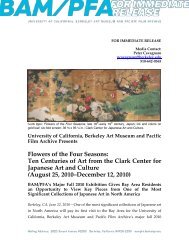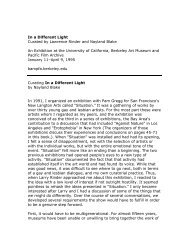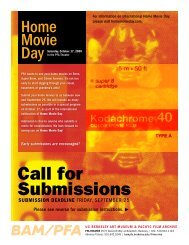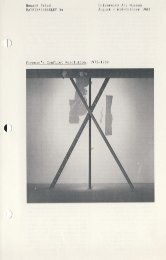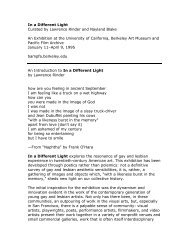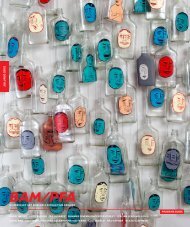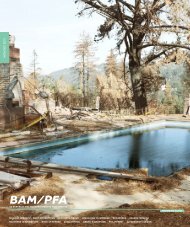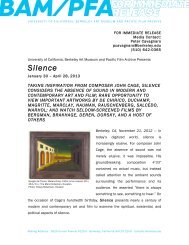exhibition brochure (PDF) - Berkeley Art Museum and Pacific Film ...
exhibition brochure (PDF) - Berkeley Art Museum and Pacific Film ...
exhibition brochure (PDF) - Berkeley Art Museum and Pacific Film ...
Create successful ePaper yourself
Turn your PDF publications into a flip-book with our unique Google optimized e-Paper software.
The 43rd Annual<br />
University of<br />
California, <strong>Berkeley</strong><br />
Master of Fine <strong>Art</strong>s<br />
Graduate Exhibition<br />
may 17–june 16, 2013
Dru Anderson<br />
Dusadee Pang Huntrakul<br />
Erin Colleen Johnson<br />
Sahar Khoury<br />
Jess Rowl<strong>and</strong><br />
Sean Talley
The 43rd Annual<br />
University of California,<br />
<strong>Berkeley</strong> Master of Fine <strong>Art</strong>s<br />
Graduate Exhibition<br />
Each year the University of California, <strong>Berkeley</strong> <strong>Art</strong> <strong>Museum</strong> <strong>and</strong> <strong>Pacific</strong> <strong>Film</strong><br />
Archive joins forces with the Department of <strong>Art</strong> Practice to present the annual<br />
Master of Fine <strong>Art</strong>s Graduate Exhibition. For this, its 43rd iteration, we have<br />
taken this collaborative ethos a step further: we invited a Ph.D. c<strong>and</strong>idate in the<br />
History of <strong>Art</strong> Department, Yasmine Chtchourova-Van Pee, to write texts that place<br />
each graduating artist’s work in the broader contexts of art <strong>and</strong> cultural history.<br />
Walking into the <strong>exhibition</strong>, visitors may be struck by the diversity of materials<br />
<strong>and</strong> concepts on display. However, this is not surprising given the strong alliances<br />
between <strong>Art</strong> Practice <strong>and</strong> other UC <strong>Berkeley</strong> departments. As a result of<br />
interdisciplinary crossover, installations tend to be less object-based <strong>and</strong> more<br />
totalizing environments; some seemingly emerge from the residue of the studio<br />
floor, while others reconsider how to use the pedestals <strong>and</strong> furniture of traditional<br />
gallery display.<br />
I encourage you to delve into the <strong>exhibition</strong> with this <strong>brochure</strong> in h<strong>and</strong>. The latter<br />
can never fully reveal the former, but it is our hope that another, more interstitial<br />
experience seeps in from between these lines.<br />
Dena Beard assistant curator
Dru Anderson<br />
Dru Anderson’s elaborate installations of carefully rendered <strong>and</strong> lovingly detailed<br />
drawings, pastels, oils, <strong>and</strong> watercolors provide visual environments of seemingly<br />
inexhaustible extension. The artist’s prodigious output (she finishes at<br />
least three works each day <strong>and</strong> often many more) is driven by a longst<strong>and</strong>ing<br />
<strong>and</strong> dedicated practice of lucid dreaming. For many years now, she has been<br />
documenting a series of recurring, ever-mutating dreams. While this mode of<br />
working might appear akin to Surrealist experiments in automatism, the intent<br />
<strong>and</strong> effects of Anderson’s practice depart dramatically from this framework.<br />
While Surrealist artists reached into the realms of slumber hoping to tap into<br />
a transcendent reality—the “sur-” in Surrealism indicating a higher, surpassing<br />
level—Anderson’s works cast back from the world of dreams a universe<br />
of objects more perfect <strong>and</strong> more vivid than the reality they come to inhabit.<br />
Many of the objects Anderson depicts are taken from a feminine realm of consumer<br />
goods—feathered earrings, stiletto heels, decorative objects associated<br />
with the domestic sphere—which too easily invites the overdetermined language<br />
of gendered description. Fragility, delicacy, wealth of detail, ornament, excess,<br />
precision, naturalistic representation: all of these, too, have been part <strong>and</strong> parcel<br />
of a simplistic binary logic sequestering women’s art practices from <strong>Art</strong> proper.<br />
However, feminist art historian Marsha Meskimmon suggests that it is exactly<br />
elaboration, a seminal aspect of Anderson’s practice, that is crucial to overturning<br />
this logic. Elaboration, she notes, “thought through drawing, loses track of<br />
[regulatory] time, unlaces binary stalemates, <strong>and</strong> suggests contingent forms for<br />
the articulation of sexual difference.” In a more classical, Freudian vein elaboration<br />
also emerges as the most radical aspect of the dreamwork. In Freud’s canonical<br />
The Interpretation of Dreams, secondary elaboration refers to a process that<br />
takes place both in the dream <strong>and</strong> after waking, in which a “process of expansion<br />
<strong>and</strong> embellishment of detail” helps manifest latent content. As such, it is<br />
the only element of the dreamwork able to reach into dream <strong>and</strong> reality alike,<br />
bridging conscious <strong>and</strong> unconscious thought. Anderson’s intricate installations<br />
offer us both a personal paean to the feminine <strong>and</strong> the privilege to witness that<br />
most universal of human qualities: the me<strong>and</strong>ering labors of the dreaming mind.<br />
Dru Anderson: Dreamality River, 2013 (detail); mixed-media installation; dimensions variable; courtesy of the artist.
Dusadee Pang Huntrakul<br />
Dusadee Pang Huntrakul’s most recent body of work, slyly humorous <strong>and</strong> gleefully<br />
scatological configurations of clay figurines, might belie the scope of the artist’s<br />
interdisciplinary practice. Clay is simply the newest material to enter this artist’s<br />
protean repertoire, thanks to a fortuitous seminar taught by Bay Area ceramic artist<br />
Richard Shaw. Huntrakul’s hypertactile pieces tap into the affective qualities<br />
of surface <strong>and</strong> medium while remaining irresistibly cheeky: tiny inquisitive faces<br />
grow out of decidedly excremental bodies; wild outcrops of slipshod yet comically<br />
insistent penises beckon; clear-glazed surfaces evoke a visceral slipperiness;<br />
<strong>and</strong> miniature white-tipped rice grains turn out to be emulations of gecko poop.<br />
While midcentury critic Clement Greenberg once warned against the use of a<br />
particular medium in such a way as to “intrigue us by associations with things we<br />
can experience more authentically elsewhere,” Huntrakul’s broader artistic practice<br />
can perhaps best be characterized as an investigation into what exactly that<br />
“authentic experience” might mean now, in our post-authentic world. His emphatic,<br />
willful materiality <strong>and</strong> often labor-intensive projects—in a recent work he manually<br />
traces in pencil each page of Aihwa Ong’s book Buddha is Hiding—are meant<br />
to counteract the insect-like automatisms we all use to navigate daily life, or what<br />
the artist refers to as life’s “surface logic.” Attaining medium-specific fluency, for<br />
Huntrakul, is less an attempt to come to grips with a particular medium as medium<br />
<strong>and</strong> rather a way to reach beyond the surface logic of each city in which he finds<br />
himself—Bangkok, Los Angeles, <strong>Berkeley</strong>. It constitutes a mapping of sorts of the<br />
different scopic regimes (culturally specific ways of seeing) of these cities <strong>and</strong> an<br />
invitation for the viewer to experience, through these visceral yet ludic encounters,<br />
those habits of mind <strong>and</strong> eye that inform our own most common impulses.<br />
Dusadee Hunktral: Even Air is Not Slowing You Down, 2012; clay; 21 2/3 × 10 1/4 × 6 1/3 in.; courtesy of the artist.
Erin Colleen Johnson<br />
At heart, Erin Colleen Johnson is a storyteller, a modern-day incarnation of<br />
the bards <strong>and</strong> griots of yore who traveled the l<strong>and</strong> spinning stories <strong>and</strong> singing<br />
songs, weaving intricate tapestries of fact <strong>and</strong> fiction. Perhaps to set the appropriate<br />
tone one need but mention that Johnson considers Jorge Luis Borges,<br />
that most masterful of weavers, a kindred spirit. The kernel from which<br />
her works develop is invariably an intriguing anecdote, a harvested fact or<br />
little-known history, deepened <strong>and</strong> elaborated through extensive historical<br />
research <strong>and</strong> an engaged dialogue with various sites <strong>and</strong> collaborators.<br />
On a formal level, Johnson’s approach is fundamentally situational: the final<br />
form her installations <strong>and</strong> performances take shifts according to collaborator,<br />
topic, <strong>and</strong> means at h<strong>and</strong>. Her works range from a samizdat pirate radio station<br />
run from an Oakl<strong>and</strong> closet to highly material experiments with the filmic<br />
medium, to the most ephemeral of gestures <strong>and</strong> gatherings. A constant, however,<br />
is the deeply collaborative nature of her practice, rejecting the idea of the<br />
artist as lone creator <strong>and</strong> instead diffusing the act of imbuing meaning across<br />
a network of agents, both inside <strong>and</strong> outside the arts. Her collaborators have<br />
been as diverse as her own practice: fellow artists, a dancer, a graphologist, an<br />
ice fisherman, Morse Code operators, strangers. In that sense her newest work<br />
forms a departure of sorts. Based on boxes of h<strong>and</strong>written sermons her gr<strong>and</strong>father,<br />
a preacher, bequeathed to her, collaboration here is of necessity conceptual.<br />
Johnson is often drawn to the ephemeral, if not the outright obsolete, <strong>and</strong> to<br />
gestures that seem hopeless save to the ones enacting them. This is not a melancholic<br />
impulse, nor a simply utopian one. Like stories proper, her works are deeply<br />
generative; they create echoes <strong>and</strong> reverberations that reinscribe these forgotten<br />
acts back into the social fabric of life, like ever so many tiny chain reactions.<br />
Erin Colleen Johnson: still from Hole #1, 2013; digital video; courtesy of the artist.
Sahar Khoury<br />
Sahar Khoury’s newest works, accumulative yet delicate compositions of found<br />
<strong>and</strong> discarded materials—scraps <strong>and</strong> notes, bits of fabric, fragments of stretcher<br />
bars, repurposed canvas—emphasize touch <strong>and</strong> their status as products of the<br />
human h<strong>and</strong>. The artist’s expansive structures revel in the liminal <strong>and</strong> the inbetween:<br />
they erase the boundaries between studio <strong>and</strong> artwork, between functional<br />
space <strong>and</strong> lived space, cast <strong>and</strong> object, presence <strong>and</strong> mimesis, between<br />
wall <strong>and</strong> floor <strong>and</strong> ceiling. She turns this ontological confusion of figure <strong>and</strong><br />
ground into the very essence of her practice. The surfaces of Khoury’s works are<br />
like topographical maps born from the ever-changing ecosystem of her studio.<br />
Khoury’s working process is one of continual rearrangement. A piece might<br />
start as part of a wall—layered accumulations literally attached to <strong>and</strong> growing<br />
out of her studio’s surfaces—then live for a while as autonomous form after<br />
having been torn free, <strong>and</strong> later might be reincorporated into another composition.<br />
Other works start as papier-mâché casts, accrue layers of matter <strong>and</strong><br />
paint, <strong>and</strong> have elements screwed <strong>and</strong> unscrewed, bound, nailed, taken off,<br />
plastered over. This cycle of construction, deconstruction, <strong>and</strong> reconstruction,<br />
of displacement <strong>and</strong> relocation, celebrates not only process <strong>and</strong> artistic labor,<br />
but also partial knowledges, the tentative <strong>and</strong> the slightly off-kilter. The resultant<br />
“structural vulnerability,” to use the artist’s own words, that characterizes<br />
her finished works swaps still-potent mythologies of progress <strong>and</strong> functionality<br />
for a perennial state of impermanence <strong>and</strong>, paradoxically, a laconic thereness.<br />
Khoury’s halting <strong>and</strong> beautifully imperfect works breed an acute awareness<br />
of the present in which experiencing the now surfaces as an insurgent act.<br />
Sahar Khoury: Plates <strong>and</strong> Ball on Shelf, 2012; papier-mâché, inkjet print, leather, acrylic paint; dimensions variable;<br />
courtesy of the artist.
Jess Rowl<strong>and</strong><br />
Jess Rowl<strong>and</strong>’s artworks <strong>and</strong> installations explore how sound can be embedded<br />
<strong>and</strong> embodied in physically immediate ways, aiming to close the gap<br />
between the object that produces sound <strong>and</strong> sound itself. Her works draw on<br />
the sound-conductive properties of rather unexpected materials—copper<br />
foil, metal-based inks, photosensitive paper—<strong>and</strong> the way pattern influences<br />
signal. If that sounds rather technical, the concrete phenomenological experience<br />
of Rowl<strong>and</strong>’s works is anything but. Guided by a sincere wonder for<br />
the existential strangeness of the world (or, as the artist put it, the “intense<br />
weirdness of a bag of potato chips”) <strong>and</strong> inspired by influences as diverse<br />
as Sufi mysticism, experimental music practices, <strong>and</strong> the sequined glitter of<br />
camp culture, her works provide an almost alchemical experience—they<br />
are living systems, haptic <strong>and</strong> optic, that often react to the viewer’s body.<br />
Rowl<strong>and</strong>’s latest work is anchored around home-developed arrays of flat audio<br />
speakers, made out of sheets of copper foil cut into wild swirling motifs based<br />
on Sufi Ebru drawing or expansive fields of repetitive geometric pattern <strong>and</strong><br />
attached to clear acetate or paper backing. Their h<strong>and</strong>made aesthetic <strong>and</strong><br />
glimmering fragility evokes equal parts Joseph Albers, Eva Hesse, <strong>and</strong> Ziggy<br />
Stardust. The patterns accommodate multiple sound signals but at the same<br />
time induce varying degrees of signal loss. In the artist’s most recent installation,<br />
a custom algorithm feeds the surface arrays r<strong>and</strong>omized sound samples,<br />
some created, some scavenged from consumer culture—one consists of a<br />
robotized voice reading out the content of the artist’s spam inbox—while ambient<br />
sounds <strong>and</strong> the electromagnetic fields of arrays interacting with those of a<br />
viewer’s body generate feedback loops. This creates a highly contingent soundscape<br />
that conjures the sense of being inside an organism that reacts to you as an<br />
organism. While Rowl<strong>and</strong>’s fondness for chance, then, points towards an interest<br />
in entropy <strong>and</strong> the scrambling of information, her work also speaks of regeneration<br />
<strong>and</strong> an infectious joy in the animation <strong>and</strong> transformation of materials.<br />
Jess Rowl<strong>and</strong>: Tapestry, 2013 (detail); copper foil on acetate; 48 × 18 in.; courtesy of the artist.
Sean Talley<br />
The Oxford English Dictionary defines notation as “the process or method of<br />
representing numbers, quantities, relations, etc., by a set or system of signs or<br />
symbols, for the purpose of record or analysis.” But what if that set of signs<br />
is not unequivocal What happens when we try to engineer a purely visual<br />
language, a notational system of mere shapes <strong>and</strong> forms Sean Talley’s body<br />
of work is in part a quest for a conclusive visual semiotics, the dream at the<br />
heart of modern design <strong>and</strong> arguably of many a strain of iconic avant-garde art.<br />
Consciously stripped <strong>and</strong> understated—“tidy,” to use the artist’s word—Talley’s<br />
works repurpose the strategies <strong>and</strong> visual idiom of Minimalism to subtly different<br />
ends. An earlier set of drawings, stern black-<strong>and</strong>-white images of rectangles <strong>and</strong><br />
irregular polygons, gestures towards Minimalism’s games of permutation <strong>and</strong><br />
Gestalt, yet Talley’s intricate process complicates that simple matter-of-factness;<br />
their monolithic blackness results from the careful <strong>and</strong> painstaking application<br />
<strong>and</strong> polishing of graphite powder by h<strong>and</strong>. More recent works, modular ceramics<br />
made with the aid of an extruder <strong>and</strong> a series of colorful pencil drawings, foreground<br />
the artist’s interest in developing sets of st<strong>and</strong>ardized morphemes—his<br />
own private alphabets. Talley produces the drawings by experimenting with various<br />
ways to hold several pencils in one h<strong>and</strong> at once, the widths between marks<br />
dependent on the number of fingers separating the pencils. The sculptures, composed<br />
of st<strong>and</strong>ardized tubes of extruded clay in a set number of diameters, hold<br />
the potential to be continuously rearranged, each new iteration erasing the last.<br />
Like the Minimalist objects he draws on, his works eschew the metaphorical <strong>and</strong><br />
court a certain muteness. Yet he professes he is not so much interested in what<br />
gets lost in between each iteration, each permutation, “but in what remains.”<br />
Sean Talley: OJPSDRI, 2013; clay <strong>and</strong> medium-density fiberboard; 20 × 12 × 10 in.; courtesy of the artist <strong>and</strong> Jancar Jones<br />
Gallery, Los Angeles.
Dru Anderson lives <strong>and</strong> works in Oakl<strong>and</strong>, CA <strong>and</strong> has<br />
recently exhibited at the Tallahassee <strong>Museum</strong> of Fine <strong>Art</strong> in<br />
Florida; Worth Ryder Gallery, <strong>Berkeley</strong>; <strong>and</strong> Mills College <strong>Art</strong><br />
<strong>Museum</strong>, Oakl<strong>and</strong>.<br />
Dusadee Pang Huntrakul (b. 1978) was born in Bangkok <strong>and</strong><br />
currently lives in <strong>Berkeley</strong>, CA. He has exhibited at Bangkok<br />
University <strong>Art</strong> Gallery, Thail<strong>and</strong>, <strong>and</strong> Osage Gallery, Hong Kong.<br />
Erin Johnson (b. 1985) lives in Oakl<strong>and</strong>, CA <strong>and</strong> has exhibited at<br />
Southern Exposure, Tenderloin National Forest, Root Division,<br />
Zero1 Biennial, <strong>and</strong> Shotwell Studios in San Francisco; Worth<br />
Ryder Gallery, <strong>Berkeley</strong>; <strong>and</strong> in North Carolina at Elsewhere<br />
<strong>Museum</strong>, Greensboro, <strong>and</strong> BookWorks, Asheville.<br />
Sahar Khoury (b. 1973) lives in Oakl<strong>and</strong>, CA <strong>and</strong> has exhibited<br />
at 2nd Floor Projects, Tenderloin National Forest, <strong>and</strong> Galeria<br />
de la Raza, San Francisco; New Image <strong>Art</strong>, West Hollywood;<br />
<strong>and</strong> Tangent Gallery, Detroit.<br />
Jess Rowl<strong>and</strong> is an artist, writer, <strong>and</strong> musician currently<br />
represented by Edgetone Records.<br />
Sean Talley (b. 1980) received his B.F.A. in 2003 from the San<br />
Francisco <strong>Art</strong> Institute; his work was recently shown at Jancar<br />
Jones Gallery, Los Angeles, <strong>and</strong> Important Projects, Oakl<strong>and</strong>.<br />
He lives <strong>and</strong> works in Oakl<strong>and</strong>, CA.
the annual m.f.a. <strong>exhibition</strong> at bam/pfa<br />
is made possible by the barbara berelson<br />
wiltsek endowment.<br />
Texts by Yasmine Chtchourova-Van Pee<br />
Chtchourova-Van Pee is a Ph.D. c<strong>and</strong>idate in<br />
History of <strong>Art</strong> at UC <strong>Berkeley</strong>, where she focuses<br />
on modern <strong>and</strong> contemporary African art. Her<br />
work as a writer <strong>and</strong> translator has been published<br />
in various catalogs <strong>and</strong> in publications such as<br />
Manifesta Journal, Afterall, <strong>and</strong> Modern Painters.<br />
uc berkeley art museum & pacific film archive<br />
bampfa.berkeley.edu



